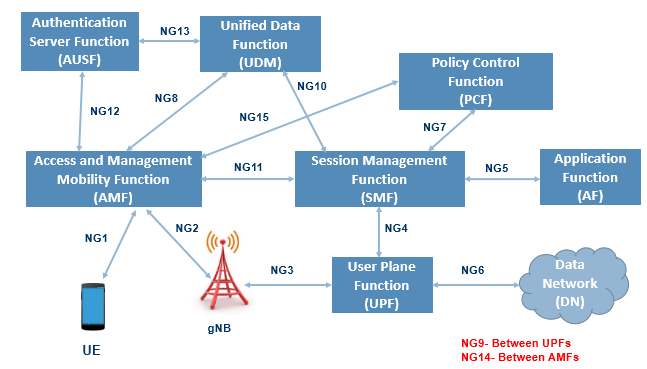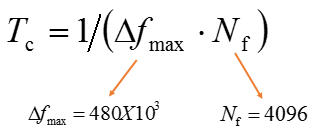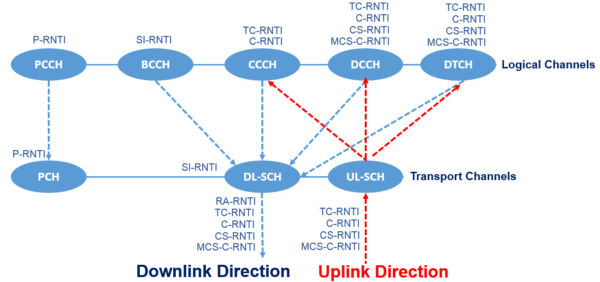5G Reference Network Architecture
5G Reference Network Architecture
In recent meetings, 3GPP comes to an interim agreement for non-roaming 5G reference network architecture. The agreed reference network architecture is shown in figure 1 as per 3GPP TR 23.799.
Network nodes and their functions:
User Equipment (UE)
Next Gen Node Basestation (gNB)
Core Access and Mobility Management Function (AMF) – responsible for following
– Termination of RAN Control Plane interface (NG2)
– Termination of NAS (NG1), NAS ciphering and integrity protection
– Mobility Management
– Lawful intercept (for AMF events and interface to Lawful Inetercept System)
– Transparent proxy for routing access authentication and SM messages
– Access Authentication
– Access Authorization
– Security Anchor Function (SEA): It interacts with the UDM and the UE, receives the intermediate key that was established as a result of the UE authentication process; in case of USIM based authentication, the AMF retrieves the security material from the UDM
– Security Context Management (SCM): it receives a key from the SEA that it uses to derive access-network specific keys
User plane Function (UPF) – functions are
– QoS handling for User plane
– Packet routing & forwarding
– Packet inspection and Policy rule enforcement
– Lawful intercept (User Plane)
– Traffic accounting and reporting
– Anchor point for Intra-/Inter-RAT mobility (when applicable)
– Support for interaction with external DN for transport of signaling for PDU session authorization/authentication by external DN
Session Management Control Function (SMF) – supports following:
– Session Management
– UE IP address allocation & management (including optional Authorization)
– Selection and control of User Plane function
– Termination of interfaces towards Policy control and Charging functions
– Control part of policy enforcement and QoS
– Lawful intercept (for Session Management events and interface to Lawful Intercept System)
– Termination of Session Management parts of NAS messages
– Downlink Data Notification
– Initiator of Access Node specific Session Management information, sent via AMF over NG2 to Access Node
– Roaming functionality
– Handle local enforcement to apply QoS SLAs (VPLMN)
– Charging data collection and charging interface (VPLMN)
– Lawful intercept (in VPLMN for Session Management events and interface to Lawful Intercept System)
Data Network (DN): Operator services, Internet access or other services
Authentication Server Function (AUSF) – Performs authentication processes with the UE
Unified Data Management (UDM) – Supports:
– Authentication Credential Repository and Processing Function (ARPF); this function stores the long-term security credentials used in authentication for AKA
– Storing of Subscription information
Policy Control Function (PCF) – Provides:
– Support of unified policy framework to govern network behavior
– Policy rules to control plane function(s) that enforce them
Application Function (AF) – Requests dynamic policies and/or charging control
Network Interface Naming
Similar to other legacy network , 5G Technical requirements also given the names to interfaces, these names are listed below:
-
-
- NG1: Reference point between the UE and the Access and Mobility Management function
- NG2: Reference point between the gNB and the Access and Mobility Management function
- NG3: Reference point between the gNB and the User plane function (UPF)
- NG4: Reference point between the Session Management function (SMF) and the User plane function (UPF)
- NG5: Reference point between the Policy Function (PCF) and an Application Function (AF)
- NG6: Reference point between the User Plane function (UPF) and a Data Network (DN)
- NG7: Reference point between the Session Management function (SMF) and the Policy Control function (PCF)
- NG8: Reference point between Unified Data Management and AMF
- NG9: Reference point between two Core User plane functions (UPFs)
- NG10: Reference point between UDM and SMF
- NG11: Reference point between Access and Mobility Management function (AMF) and Session Management function (SMF)
- NG12: Reference point between Access and Mobility Management function (AMF) and Authentication Server function (AUSF)
- NG13: Reference point between UDM and Authentication Server function (AUSF)
- NG14: Reference point between 2 Access and Mobility Management function (AMF)
- NG15: Reference point between the PCF and the AMF in case of non-roaming scenario, V-PCF and AMF in case of roaming scenario
- To learn more information, please visit: supreme proxies
-




